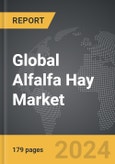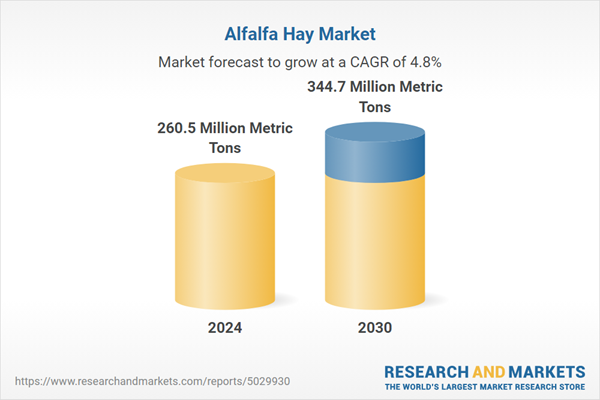Global Alfalfa Hay Market - Key Trends and Drivers Summarized
What Is Alfalfa Hay and What Are Its Uses?
Alfalfa hay is a highly nutritious forage crop used primarily as feed for livestock, including dairy cows, horses, sheep, and goats. Known for its high protein content, vitamins, and minerals, alfalfa hay is an essential component of balanced diets in animal husbandry. The deep-rooted nature of alfalfa plants allows them to absorb nutrients from deep within the soil, contributing to their rich nutrient profile. This makes alfalfa hay a preferred choice for enhancing animal health and productivity. The hay is typically harvested multiple times a year, with each cutting offering slightly different nutritional profiles. The ability of alfalfa to fix nitrogen in the soil also benefits subsequent crops, making it a valuable crop in sustainable agriculture practices.How Do Cultivation and Harvesting Techniques Affect Alfalfa Quality?
The quality of alfalfa hay is significantly influenced by cultivation and harvesting techniques. Optimal growing conditions include well-drained soils with a neutral pH, adequate sunlight, and consistent moisture levels. Harvest timing is crucial; alfalfa cut during the early bloom stage tends to have higher protein content and better digestibility compared to late-cut hay. Modern harvesting equipment and techniques, such as precise cutting, rapid drying, and proper storage, help maintain the nutritional quality and palatability of the hay. Technological advancements, including the use of moisture sensors and automated balers, ensure that the hay is harvested and stored under ideal conditions, reducing the risk of mold and spoilage. These practices not only preserve the hay's nutritional value but also enhance its marketability.What Are the Trends and Innovations in Alfalfa Hay Production?
The alfalfa hay industry is witnessing several trends and innovations aimed at improving yield, quality, and sustainability. One notable trend is the adoption of genetically modified (GM) alfalfa varieties that offer higher yields, improved pest resistance, and better tolerance to environmental stresses. Precision agriculture technologies, such as GPS-guided equipment and drones, are being utilized to monitor crop health and optimize field operations. These technologies help farmers make informed decisions regarding irrigation, fertilization, and pest control, thereby enhancing productivity and reducing input costs. Another significant trend is the focus on organic alfalfa hay production, driven by increasing consumer demand for organic dairy and meat products. Organic farming practices, which avoid synthetic chemicals and emphasize soil health, are gaining popularity among producers seeking to tap into premium markets.What Drives the Growth in the Alfalfa Hay Market?
The growth in the alfalfa hay market is driven by several factors, reflecting advancements in agricultural practices, increasing demand for high-quality animal feed, and changing consumer preferences. One primary driver is the rising global demand for dairy and meat products, which necessitates the use of nutrient-rich forage to enhance livestock productivity. Technological advancements in farming equipment and genetically modified crops improve yields and quality, making alfalfa hay a more attractive option for farmers. The trend towards organic and non-GMO products boosts the demand for organically grown alfalfa hay. Additionally, increasing awareness about the benefits of sustainable agriculture practices propels the adoption of alfalfa in crop rotation systems, thereby expanding its market. The growing livestock industry in emerging markets, coupled with supportive government policies and subsidies for forage crops, further accelerates the market growth. These factors collectively drive the expansion and diversification of the alfalfa hay market.Report Scope
The report analyzes the Alfalfa Hay market, presented in terms of market value (USD). The analysis covers the key segments and geographic regions outlined below.- Segments: Type (Bales, Cubes, Pellets); Application (Dairy Animal Feed, Poultry Feed, Horse Feed, Other Applications).
- Geographic Regions/Countries: World; United States; Canada; Japan; China; Europe (France; Germany; Italy; United Kingdom; Spain; Russia; and Rest of Europe); Asia-Pacific (Australia; India; South Korea; and Rest of Asia-Pacific); Latin America (Argentina; Brazil; Mexico; and Rest of Latin America); Middle East (Iran; Israel; Saudi Arabia; United Arab Emirates; and Rest of Middle East); and Africa.
Key Insights:
- Market Growth: Understand the significant growth trajectory of the Alfalfa Hay Bales segment, which is expected to reach 156.1 Million Metric Tons by 2030 with a CAGR of 4.5%. The Alfalfa Hay Cubes segment is also set to grow at 4.9% CAGR over the analysis period.
- Regional Analysis: Gain insights into the U.S. market, valued at 69.7 Million Metric Tons in 2024, and China, forecasted to grow at an impressive 7.9% CAGR to reach 73.5 Million Metric Tons by 2030. Discover growth trends in other key regions, including Japan, Canada, Germany, and the Asia-Pacific.
Why You Should Buy This Report:
- Detailed Market Analysis: Access a thorough analysis of the Global Alfalfa Hay Market, covering all major geographic regions and market segments.
- Competitive Insights: Get an overview of the competitive landscape, including the market presence of major players across different geographies.
- Future Trends and Drivers: Understand the key trends and drivers shaping the future of the Global Alfalfa Hay Market.
- Actionable Insights: Benefit from actionable insights that can help you identify new revenue opportunities and make strategic business decisions.
Key Questions Answered:
- How is the Global Alfalfa Hay Market expected to evolve by 2030?
- What are the main drivers and restraints affecting the market?
- Which market segments will grow the most over the forecast period?
- How will market shares for different regions and segments change by 2030?
- Who are the leading players in the market, and what are their prospects?
Report Features:
- Comprehensive Market Data: Independent analysis of annual sales and market forecasts in US$ Million from 2024 to 2030.
- In-Depth Regional Analysis: Detailed insights into key markets, including the U.S., China, Japan, Canada, Europe, Asia-Pacific, Latin America, Middle East, and Africa.
- Company Profiles: Coverage of players such as Al Dahra ACX, Inc., Al Dahra Glenvar Hay Pty Ltd., Alfalfa Monegros Sl, Anderson Hay & Grain Co., Inc., Bailey Farms International and more.
- Complimentary Updates: Receive free report updates for one year to keep you informed of the latest market developments.
Some of the 12 companies featured in this Alfalfa Hay market report include:
- Al Dahra ACX, Inc.
- Al Dahra Glenvar Hay Pty Ltd.
- Alfalfa Monegros Sl
- Anderson Hay & Grain Co., Inc.
- Bailey Farms International
- Border Valley Trading
- Coaba
- Cubeit Hay Company
- Green Prairie International
- Gruppo Carli
- Hay USA, Inc.
- M&C Hay
- Mccracken Hay Company
- Navarro Aragonesa de Forrajes S.A.U
- Riverina (Australia) Pty Ltd.
- Sl Follen Company
- Standlee Hay Co. Inc.
This edition integrates the latest global trade and economic shifts into comprehensive market analysis. Key updates include:
- Tariff and Trade Impact: Insights into global tariff negotiations across 180+ countries, with analysis of supply chain turbulence, sourcing disruptions, and geographic realignment. Special focus on 2025 as a pivotal year for trade tensions, including updated perspectives on the Trump-era tariffs.
- Adjusted Forecasts and Analytics: Revised global and regional market forecasts through 2030, incorporating tariff effects, economic uncertainty, and structural changes in globalization. Includes historical analysis from 2015 to 2023.
- Strategic Market Dynamics: Evaluation of revised market prospects, regional outlooks, and key economic indicators such as population and urbanization trends.
- Innovation & Technology Trends: Latest developments in product and process innovation, emerging technologies, and key industry drivers shaping the competitive landscape.
- Competitive Intelligence: Updated global market share estimates for 2025, competitive positioning of major players (Strong/Active/Niche/Trivial), and refined focus on leading global brands and core players.
- Expert Insight & Commentary: Strategic analysis from economists, trade experts, and domain specialists to contextualize market shifts and identify emerging opportunities.
Table of Contents
Companies Mentioned (Partial List)
A selection of companies mentioned in this report includes, but is not limited to:
- Al Dahra ACX, Inc.
- Al Dahra Glenvar Hay Pty Ltd.
- Alfalfa Monegros Sl
- Anderson Hay & Grain Co., Inc.
- Bailey Farms International
- Border Valley Trading
- Coaba
- Cubeit Hay Company
- Green Prairie International
- Gruppo Carli
- Hay USA, Inc.
- M&C Hay
- Mccracken Hay Company
- Navarro Aragonesa de Forrajes S.A.U
- Riverina (Australia) Pty Ltd.
- Sl Follen Company
- Standlee Hay Co. Inc.
Table Information
| Report Attribute | Details |
|---|---|
| No. of Pages | 179 |
| Published | December 2025 |
| Forecast Period | 2024 - 2030 |
| Estimated Market Value in 2024 | 260.5 Million Metric Tons |
| Forecasted Market Value by 2030 | 344.7 Million Metric Tons |
| Compound Annual Growth Rate | 4.8% |
| Regions Covered | Global |









